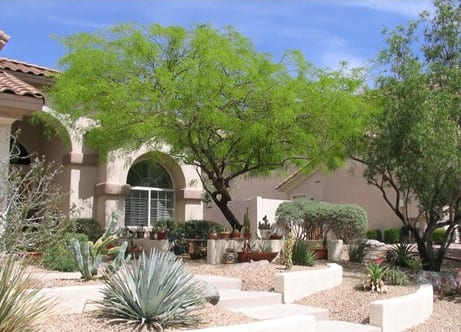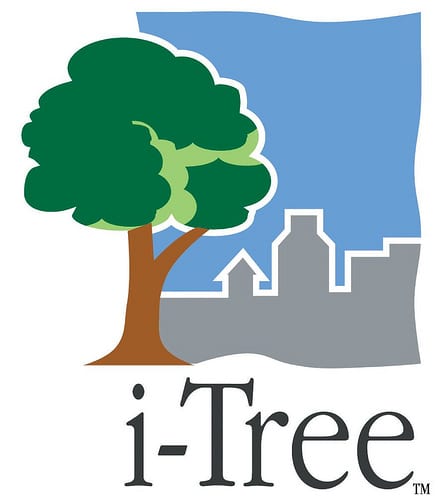by Dr. Susannah B. Lerman
Trees and other vegetation deliver numerous essential ecosystem services in urban and suburban communities. In particular, the trees store and sequester carbon, help mitigate the urban heat island effect through evapotranspiration and by providing shade, and have the capacity to infiltrate stormwater runoff, thus alleviating flood risk (Nowak et al. 2001). Both urban and suburban vegetation also has the capacity to provide habitat for birds, pollinators, and other wildlife. This is important due to the role birds and other wildlife play in their contribution to ecosystem functioning. They disperse seed, pollinate plants, scavenge carrion, and consume pests. Further, their activities also deliver ecosystem services that have direct benefits to people. In particular, bees can help increase economic yields in agriculture, insectivorous birds and raptors provide pest control of insect outbreaks and rodents, and vultures and other scavengers dispose of waste (Luck et al. 2011). Birds also contribute to local economies via tourism (i.e., birdwatching trips) and the purchase of birdseed and other bird feeding products. And finally, birds add to the quality of life by boosting cultural and spiritual well-being, enhancing aesthetic experiences and strengthening sense of place (Luck et al. 2011).
Habitat degradation from urban development represents one of the greatest threats to birds and other wildlife. The development process results in the removal and fragmentation of vegetation and has negatively impacted many species of birds, other wildlife, and ecosystem processes (Grimm et al. 2008). Because of the stark differences between intact forests and young suburban neighborhoods, the two landscapes can be categorized as “habitat” and “non-habitat.” However, after the initial disturbance from construction, novel habitats emerge in neighborhoods and other urban areas. The resulting altered landscape constitutes a complex mosaic of invasive, exotic, and native plants; large swaths of lawns; contiguous forests; and isolated trees.
Landscape Decisions Affect Wildlife
From a landscape perspective, we might observe a homogenizing force with regards to the urban form of American cities and suburbs. For example, from 3000 feet above ground, it is difficult to differentiate Boston from Phoenix. Birds inhabiting cities have also become homogenized with most American cities supporting an abundance of European starlings, rock pigeons, and house sparrows. However, when we home in on local scales, i.e., neighborhoods or even different land uses within a city, we find a tremendous amount of heterogeneity with regards to habitat. At the street view, there are stark and sometimes subtle differences in tree and shrub composition, tree condition and density, and specific management decisions. The heterogeneity thus has implications for habitat quality.

An example of a Phoenix yard landscaped with palo verdes (Parkinsonia florida), mesquites (Prosopis spp), and other desert vegetation.
For example, in Phoenix, AZ, neighborhoods with higher abundances of desert trees support more desert birds (Lerman and Warren 2011), and in the Washington DC metro region, yards with at least 70% of their plants native support higher densities of Lepidoptera, which equates to higher nest success for Carolina chickadees (Narango et al. 2018). In addition to the types of trees, the decisions we make in managing urban and suburban vegetation can also have profound implications for wildlife. For example, in lawn-dominated yards in suburban Springfield, MA, lawns that were mowed less frequently supported higher abundances of bees due to an increased number of lawn flowers (e.g., dandelions and clover; Lerman et al. 2018). We find that doing less, or being a “lazy lawnmower” can also contribute to wildlife habitat.

Mowing lawns less frequently to allow dandelions and clover to flower provides significant habitat for pollinators.
Tools to Assess Habitat
It is estimated that urban land cover in North America will double between 2000 and 2030 (Seto et al. 2012), consuming millions of acres of forested lands. Thus, it’s important to identify effective and innovative urban habitat assessment tools that can help reconcile urban development and wildlife habitat. Tools can help ensure that conservation efforts and plans for enhancing and protecting the urban forest will lead to sustainable populations of birds and other desirable wildlife. With this in mind, research scientists from the US Forest Service developed a wildlife tool for i-Tree, the US Forest Service’s urban forest assessment program. The tool provides detailed information on habitat requirements for a variety of songbirds, evaluates the bird habitat potential at ecoregional scales, and guides habitat improvement plans (Lerman et al. 2014).
 The wildlife tool is based on i-Tree field data, which quantifies the forest structure in various land uses throughout a city. Variables include the amount of impervious surface, shrub density, tree height, tree condition, tree size, and the maintenance status of lawns. These data were used to develop equations that modelled the relationship between habitat and nine bird species representing a range of life history traits and conservation status. The equations were integrated into i-Tree software and applied to urban forest datasets to calculate both the bird species’ overall habitat suitability for a city or a delineated i-Tree project and the species’ habitat suitability for different types of land use (e.g., residential, commercial, parkland).
The wildlife tool is based on i-Tree field data, which quantifies the forest structure in various land uses throughout a city. Variables include the amount of impervious surface, shrub density, tree height, tree condition, tree size, and the maintenance status of lawns. These data were used to develop equations that modelled the relationship between habitat and nine bird species representing a range of life history traits and conservation status. The equations were integrated into i-Tree software and applied to urban forest datasets to calculate both the bird species’ overall habitat suitability for a city or a delineated i-Tree project and the species’ habitat suitability for different types of land use (e.g., residential, commercial, parkland).
Practical Application
To assess the habitat potential of a particular area, the wildlife tool models the actual habitat conditions (i.e., the percent of tree cover in a particular neighborhood or city park) with the desired amount of canopy cover required by a species and calculates a sustainability score (0-1). The score is fed back into the i-Tree program to provide the likelihood of a plot, a specific land use, or an entire city to support the species, based on the existing habitat conditions. For example, the red-bellied woodpecker is a relatively common species that excavates nests in dead wood and is easily recognized by its loud yet rich call and conspicuous nature of perching on tree trunks.

The habitat suitability index model from the i-Tree wildlife tool depicting the relationship between percent tree canopy cover and the suitability of supporting red-bellied woodpeckers. As the amount of canopy cover increases, so does the suitability. However, suitability peaks between 35% and 65% canopy cover. The models guide managers with specific habitat goals to help increase the urban forest for birds and other wildlife.
In addition to dead wood, the species also requires a moderate to dense tree canopy cover, between 35% and 65%. Percent canopy cover in Philadelphia residential neighborhoods is estimated at 12.5% while natural areas have 75%. In combination with other habitat features important for supporting red-bellied woodpeckers (e.g., abundance of large trees and trees with dead wood), residential areas have a low suitability score (0.2) compared with natural areas (0.75). City-wide, Philadelphia has a suitability score of 0.4, which is relatively good for this species. When habitat suitability scores are low, managers can assess where discrepancies exist between the actual forest conditions and desired habitat features. Thus, the bird habitat models have the capacity to identify specific conditions (i.e., canopy percent or dead wood density) that urban foresters and planners can target when determining how to manage the urban forest for wildlife. Further, because of the flexibility of the tool to assess different spatial scales, i-Tree wildlife can provide detailed information and localized solutions for wildlife management projects (Lerman et al. 2014).
Integrating validated bird habitat suitability models into i-Tree can provide a more comprehensive assessment of the ecosystem services offered by the urban forest. Essentially, the models translate the i-Tree raw data’s detailed information on the forest composition and structure into relative assessments of habitat value for birds. The bird habitat models suggest which species specifically, and guilds broadly, can be supported by an urban forest. When urban forests support wildlife, they also provide opportunities for urban dwellers to connect with nearby nature. This is important given that more than 80% of Americans live in cities and suburbs and that is where they have their primary interactions with the natural world. The connection can improve and enhance well-being while generating interest and support for conservation initiatives that aim to further improve urban biodiversity while delivering benefits to people and wildlife.
Literature cited
Grimm, N. B., Faeth, S. H., Golubiewski, N. E., Redman, C. L., Wu, J., Bai, X., & Briggs, J. M. (2008). Global change and the ecology of cities. Science, 319(5864), 756–760. https://doi.org/10.1126/science.1150195
Lerman, S.B., & Warren, P. S. (2011). The conservation value of residential yards: linking birds and people. Ecological Applications, 21(4), 1327–1339.
Lerman, S. B., Nislow, K. H., Nowak, D. J., DeStefano, S., King, D. I., & Jones-Farrand, D. T. (2014). Using urban forest assessment tools to model bird habitat potential. Landscape and Urban Planning, 122, 29–40.
Lerman, Susannah B., Contosta, A. R., Milam, J., & Bang, C. (2018). To mow or to mow less: Lawn mowing frequency affects bee abundance and diversity in suburban yards. Biological Conservation, 221, 160–174. https://doi.org/10.1016/j.biocon.2018.01.025
Luck, G. W., Davidson, P., Boxall, D., & Smallbone, L. (2011). Relations between urban bird and plant communities and human well‐being and connection to nature. Conservation Biology, 25(4), 816–826. https://doi.org/10.1111/j.1523-1739.2011.01685.x
Narango, D. L., Tallamy, D. W., & Marra, P. P. (2018). Nonnative plants reduce population growth of an insectivorous bird. Proceedings of the National Academy of Sciences, 115(45), 11549–11554. https://doi.org/10.1073/pnas.1809259115
Nowak, D. J., Noble, M. H., Sisinni, S. M., & Dwyer, J. F. (2001). People and trees: assessing the US urban forest resource. Journal of Forestry, 99(3), 37–42.
About the Author
Dr. Susannah Lerman is a Research Ecologist in the Communities and Landscapes of the Urban Northeast unit of the USDA Forest Service. Dr. Lerman earned her BA in American History from the University of Delaware, an M. in Conservation Biology from Antioch University, and a PhD in Organismic and Evolutionary Biology from the University of Massachusetts in 2011. Her research identifies creative strategies for managing yards, neighborhood parks, and other open spaces with the dual objective of creating vibrant habitats for wildlife and people. Dr. Lerman seeks opportunities to explain scientific findings to varying audiences while trying to facilitate connections between the public’s personal lives and their local environment. Her research has been highlighted in a number of national and international media outlets including NPR’s Science Friday, The National Audubon Magazine, and The Guardian. Dr. Lerman is a keen birder, who also enjoys running in the woods and along back roads and hiking in the desert.



